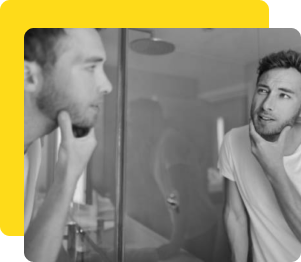Beard Transplant
If you’re struggling with patchy or thin facial hair, a beard transplant may be a solution worth considering. A beard hair transplant involves transplanting hair follicles from one part of your body to your beard area, resulting in a fuller and thicker beard. This guide will discuss some important aspects of beard hair transplant you need to know. You will learn about beard transplant before and after, beard transplant results, and beard hair transplant.
Procedure: Beard Hair Transplant
Duration: 4 – 8 hours
Length of Stay in Hospital : Same day treatment
Cost in Turkey: €1350 – €1750
Anesthesia: Local anesthesia
Success Rate: 90% – 95%
Final Results: After 9 months – 12 months
Scars: No
Pain: Slight
What is Beard Transplant?
A beard transplant is a cosmetic procedure that involves taking hair from the back of the scalp and transplanting it onto the face, resulting in a fuller and more natural-looking beard.
In some cases, a hair and beard transplant may be necessary to achieve the desired look. This involves transplanting both scalp and facial hair to create a cohesive and natural appearance.
While the procedure may seem daunting, a successful beard transplant can boost your confidence and transform your appearance.
Turkey has become a popular destination for this procedure, with many clinics offering affordable beard transplant cost options compared to other countries.

Types of Beard Transplant Techniques
Follicular Unit Transplantation (FUT)
If you are considering a beard hair transplant, you may have come across Follicular Unit Transplantation (FUT) as a potential option.
This technique involves removing a strip of hair follicles from the back of the scalp and transplanting them to the beard area.
Here are some advantages and disadvantages of FUT for beard hair transplant:
Advantages of Follicular Unit Transplatation
- FUT allows for a larger number of hair follicles to be transplanted at once, which can lead to more significant results in a single session.
- The transplanted hair follicles are typically harvested from an area of the scalp with strong, healthy hair growth, which can improve the chances of success for the transplant.
- The transplanted hair follicles are genetically resistant to hair loss, which means that the results of FUT are permanent.
Disadvantages of Follicular Unit Transplantation
- The linear scar left by the FUT procedure may be visible if the hair is cut short, which may be a concern for individuals who prefer shorter hairstyles.
- FUT can be a more invasive procedure compared to other hair transplant techniques, which can lead to longer recovery times and potential complications.
- The FUT technique may not be suitable for individuals with very curly or coiled hair, as it can be difficult to extract hair follicles without damaging them.
Overall, FUT can be a viable option for beard hair transplant, but it is important to weigh the advantages and disadvantages carefully and consult with a qualified hair transplant specialist to determine the best approach for your individual needs.
Follicular Unit Extraction (FUE)
- One of the most significant benefits of FUE is that it is minimally invasive, leaving behind minimal scarring.
- FUE allows for the transplantation of individual hair follicles, which means a more natural-looking result.
- FUE can be used to transplant hair from other parts of the body to the face, making it a viable option for those with patchy beards or bald spots.
- The recovery time for FUE is relatively short, with most patients being able to return to work within a few days.
- One disadvantage of FUE is that it can be more expensive than other hair transplant methods, which may be a concern for some individuals.
- FUE is a time-consuming procedure and may require multiple sessions to achieve the desired results.
- In rare cases, patients may experience complications such as infection or scarring.
How To Prepare for Beard Hair Transplant
Preparing for a beard hair transplant is an important step toward achieving the best possible results from the procedure. Here are some steps you can take to prepare for a beard hair transplant:
Consultation with the surgeon: During the consultation, the surgeon will examine your beard area, discuss the procedure with you, and answer any questions you may have including hair and beard transplant cost.
Stop Smoking: If you are a smoker, it’s essential to stop smoking at least two weeks before the procedure. Smoking can affect the healing process and increase the risk of complications.
Avoid blood-thinning medications: Avoid taking blood-thinning medications, such as aspirin or ibuprofen, for two weeks before the procedure. These medications can increase the risk of bleeding during and after the surgery.
Take care of your scalp: Keep your scalp healthy and clean in the days leading up to the surgery. This can help prevent infection and promote healing.
Follow the pre-operative instructions: Your surgeon will provide you with a list of instructions to follow before the procedure, such as not eating or drinking anything for a certain period before the surgery.
By taking these steps and following your surgeon’s instructions, you can help ensure that you’re fully prepared for the beard hair transplant surgery and that you get the best possible results from the procedure.
How is Beard Hair Transplant Procedure Work?
If you’re considering a beard hair transplant, it’s natural to wonder what the procedure entails. Here’s a step-by-step guide to help you understand what to expect:
Consultation: Before the procedure, you’ll have a consultation with a hair transplant surgeon. During this time, they’ll assess your beard, discuss your goals, and determine if you’re a suitable candidate for the procedure.
Anesthesia: On the day of the procedure, the surgeon will administer local anesthesia to numb the area where the hair follicles will be harvested and transplanted.
Extraction: Once the anesthesia has taken effect, the surgeon will use a small punch tool to extract individual hair follicles from the donor area. This area is usually the back of the scalp, where hair growth is dense and healthy.
Preparation: The extracted hair follicles will be carefully prepared for transplantation. This involves sorting them by size, shape, and color to ensure a natural-looking result.
Implantation: Using a tiny needle, the surgeon will make small incisions in the beard area where the hair follicles will be transplanted. The extracted hair follicles will then be inserted into these incisions, one by one.
Post-procedure care: After the procedure, you’ll be given instructions on how to care for the transplanted hair follicles. This typically includes keeping the area clean and avoiding any strenuous activities that could disrupt the healing process.
What To Expect During Recovery and Results
A hair and beard transplant can provide natural-looking results, but recovery may involve minor discomfort and swelling that can be managed with medication.
Aftercare instructions should be followed carefully, and extreme temperatures should be avoided for several weeks.
Shedding of transplanted hair is normal, and final results may take up to a year to be visible. The beard transplant cost Turkey can vary, so it’s essential to research and compare prices before deciding on a clinic.
Overall, patience and proper care can result in a fuller, more attractive beard after a hair and beard transplant.
The cost of a beard transplant can vary depending on the extent of the procedure and the clinic you choose. On average, beard hair transplant cost is around €1350 – €1750, but it can be higher for more complex cases.
Many clinics offer financing options to make the procedure more accessible to patients who may not be able to pay the full amount upfront.
Financing options can include payment plans or medical loans, allowing patients to spread out the cost over time.
If you’re considering a beard transplant, it’s essential to research and compares prices to find a reputable clinic that offers financing options that work for you.
Tips for Maintaining a Healthy Beard Post-Transplant
Here are some tips for maintaining a healthy beard post-transplant:
- Keep the area clean to prevent infection and promote healing.
- Avoid touching or scratching the transplanted area to prevent damage.
- Use a gentle shampoo and conditioner to keep the hair clean and moisturized.
- Use beard oil or balm to keep the hair and skin moisturized and prevent dryness and itching.
- Brush or comb the beard regularly to promote healthy hair growth.
- Trim the beard regularly to maintain its shape and prevent split ends.
- Avoid using harsh chemicals or heat-styling tools on the beard.
Combining Beard Transplants with Other Facial Hair Procedures
Combining a beard transplant with additional facial hair procedures can help achieve a more cohesive and balanced look.
Two common procedures that can be combined with a beard transplant are mustache and sideburn transplants.
- Mustache transplants
A mustache transplant involves harvesting healthy hair follicles from the donor area and implanting them into the upper lip area to create a fuller and more defined mustache.
This procedure is ideal for individuals who have thin or patchy hair growth in their mustache area.
- Sideburn transplants
A sideburn transplant involves harvesting hair follicles from the donor area and implanting them into the sideburn area to create a more defined and symmetrical appearance.
This procedure is ideal for individuals who have thin or patchy hair growth in their sideburn area.
Beard Transplant Alternatives
Here are some beard transplant alternatives:
- Topical hair growth products
- Microblading or tattooing
- Using facial hair prosthetics
- Facial hair transplant using other donor areas
- Using facial hair transplant alternatives such as synthetic hair implants or platelet-rich plasma (PRP) therapy.
Conclusion
If you’re ready to take the next step, we recommend researching reputable clinics and scheduling a consultation with a qualified surgeon to discuss your options.
Frequently Asked Questions (FAQs)
The cost of a beard transplant can vary depending on several factors, such as the number of grafts needed and the location of the clinic. On average, it can cost between €1350 – €1750, but it can be higher for more complex cases
Yes, beard transplants are considered a permanent solution for facial hair loss. The transplanted hair follicles are taken from areas on the body where hair growth is permanent, such as the back of the head.
The transplanted hairs should last a lifetime, but shedding can occur during the first few weeks. Once the hairs are fully integrated into the beard, they will grow and behave like natural hair.
Like any surgery, there are some risks involved with beard transplants, such as bleeding, infection, or scarring. However, with a qualified surgeon and proper aftercare, risks can be minimized.
There is no specific age for a beard transplant, but patients should be in good health and have fully developed facial hair growth patterns.
Once the transplanted hairs have fully grown, they can be shaved or groomed like any other facial hair. However, it’s important to avoid shaving the area for the first few weeks after the procedure to allow for proper healing.
